maintenance YAMAHA GRIZZLY 450 2014 Owners Manual
[x] Cancel search | Manufacturer: YAMAHA, Model Year: 2014, Model line: GRIZZLY 450, Model: YAMAHA GRIZZLY 450 2014Pages: 174, PDF Size: 3.99 MB
Page 6 of 174

EBU17170
INTRODUCTION
EBU17292Congratulations on your purchase of the Yamaha YFM450DE/YFM450PE/YFM450PHE. This ATV repre-
sents the result of many years of Yamaha experience in the production of fine sporting, touring, and pace-
setting racing machines. With the purchase of this Yamaha, you can now appreciate the high degree of
craftsmanship and reliability that have made Yamaha a leader in these fields.
This manual will provide you with a good basic understanding of the features and operation of this ATV.
This manual includes important safety information. It provides information about special tech-
niques and skills necessary to ride the ATV. It also includes basic maintenance and inspection proce-
dures. If you have any questions regarding the operation or maintenance of your ATV, please consult a
Yamaha dealer.
AN IMPORTANT SAFETY MESSAGE:●Read this manual completely before operating your ATV. Make sure you understand all instructions.●Pay close attention to the warning and notice labels on the ATV.●This ATV should not be ridden by anyone under 16 years of age.
U2LC60E0.book Page 1 Friday, March 8, 2013 1:18 PM
Page 10 of 174

Starting a warm engine .............................. 6-3
Operating the drive select lever and driving in reverse ................................................. 6-3
Engine break-in .......................................... 6-5
Parking ....................................................... 6-5
Parking on a slope ..................................... 6-6
Accessories and loading ............................ 6-6
RIDING YOUR ATV ...................................... 7-1 GETTING TO KNOW YOUR ATV............... 7-2
RIDE WITH CARE AND GOOD JUDGMENT .............................................. 7-2
BE CAREFUL WHERE YOU RIDE ............. 7-9
TURNING YOUR ATV .............................. 7-12
CLIMBING UPHILL ................................... 7-13
RIDING DOWNHILL.................................. 7-16
CROSSING A SLOPE............................... 7-17
CROSSING THROUGH SHALLOW WATER ................................................... 7-18
RIDING OVER ROUGH TERRAIN ........... 7-21
SLIDING AND SKIDDING ......................... 7-21
WHAT TO DO IF... .................................... 7-22
WHAT TO DO... ........................................ 7-23
PERIODIC MAINTENANCE AND
ADJUSTMENT ............................................... 8-1 Owner’s manual and tool kit ....................... 8-2 Periodic maintenance chart for the
emission control system ...........................8-3
General maintenance and lubrication chart ..........................................................8-5
Removing and installing panels ................8-10
Checking the spark plug ...........................8-14
Engine oil and oil filter cartridge ................8-17
Final gear oil .............................................8-21
Differential gear oil ....................................8-24
Coolant .....................................................8-26
Cleaning the air filter element ...................8-30
Cleaning the spark arrester ......................8-33
V-belt cooling duct check hose .................8-35
V-belt case drain plug ...............................8-35
Adjusting the carburetor ............................8-36
Adjusting the engine idling speed .............8-36
Adjusting the throttle lever free play .........8-37
Valve clearance ........................................8-38
Adjusting the drive select lever safety system cable ...........................................8-38
Brakes .......................................................8-38
Checking the front brake pads and rear brake friction plates .................................8-39
Checking the brake fluid level ...................8-40
Changing the brake fluid ...........................8-41
Checking the front brake lever free play ...8-41
U2LC60E0.book Page 2 Friday, March 8, 2013 1:18 PM
Page 24 of 174

2-2
2
●Never operate at speeds too fast for your skills
or the riding conditions. Always go at a speed
that is proper for the terrain, visibility, operating
conditions, and your experience.●Never attempt wheelies, jumps, or other stunts.●Always inspect your ATV each time you use it to
make sure it is in safe operating condition. Al-
ways follow the inspection and maintenance
procedures and schedules described in this
manual.●Always keep both hands on the handlebars and
both feet on the footboards of the ATV during
operation.●Always go slowly and be extra careful when op-
erating on unfamiliar terrain. Always be alert to
changing terrain conditions when operating the
ATV.●Never operate on excessively rough, slippery or
loose terrain until you have learned and prac-
ticed the skills necessary to control the ATV on
such terrain. Always be especially cautious on
these kinds of terrain.●Always follow proper procedures for turning as
described in this manual. Practice turning at low
speeds before attempting to turn at faster
speeds and never turn at excessive speeds.
●Never operate the ATV on hills too steep for the
ATV or for your abilities. Practice on smaller hills
before attempting larger hills.●Always follow proper procedures for climbing
hills as described in this manual. Check the ter-
rain carefully before you start up any hill. Never
climb hills with excessively slippery or loose sur-
faces. Shift your weight forward. Never open the
throttle suddenly. Never go over the top of a hill
at high speed.●Always follow proper procedures for going down
hills and for braking on hills as described in this
manual. Check the terrain carefully before you
start down any hill. Shift your weight backward.
Never go down a hill at high speed. Avoid going
down a hill at an angle that would cause the ve-
hicle to lean sharply to one side. Go straight
down the hill where possible.●Always follow proper procedures for crossing
the side of a hill as described in this manual.
Avoid hills with excessively slippery or loose sur-
faces. Shift your weight to the uphill side of the
ATV. Never attempt to turn the ATV around on
any hill until you have mastered the turning tech-
nique described in this manual on level ground.
Avoid crossing the side of a steep hill if possible.
U2LC60E0.book Page 2 Friday, March 8, 2013 1:18 PM
Page 25 of 174

2-3
2
●Always use proper procedures if you stall or roll
backwards when climbing a hill. To avoid stall-
ing, use the proper gear range and maintain a
steady speed when climbing a hill. If you stall or
roll backwards, follow the special procedure for
braking described in this manual. Dismount on
the uphill side or to a side if pointed straight up-
hill. Turn the ATV around and remount, following
the procedure described in this manual.●Always check for obstacles before operating in a
new area.●Never attempt to operate over large obstacles,
such as large rocks or fallen trees. Always follow
proper procedures when operating over obsta-
cles as described in this manual.●Always be careful when skidding or sliding.
Learn to safely control skidding or sliding by
practicing at low speeds and on level, smooth
terrain. On extremely slippery surfaces, such as
ice, go slowly and be very cautious in order to re-
duce the chance of skidding or sliding out of con-
trol.●Never operate an ATV in fast flowing water or in
water deeper than that recommended in this
manual. Remember that wet brakes may havereduced stopping ability. Test your brakes after
leaving water. If necessary, apply them several
times to let friction dry out the linings.
●Always be sure there are no obstacles or people
behind you when you operate in reverse. When
it is safe to proceed in reverse, go slowly.●Always use the size and type of tires specified in
this manual.●Always maintain proper tire pressure as de-
scribed in this manual.●Never exceed the stated load capacity for an
ATV. Cargo should be properly distributed and
securely attached. Reduce speed and follow in-
structions in this manual for carrying cargo or
pulling a trailer. Allow greater distance for brak-
ing.●Do not operate your ATV during darkness un-
less it is equipped with a properly functioning
headlight. Off-road riding is inherently danger-
ous and additionally, off-road trails do not have
streetlights to guide you.●Never maintain an ATV without proper knowl-
edge. Contact an authorized ATV dealer to in-
form you on basic ATV maintenance. Certain
maintenance can only be carried out by certified
staff.
U2LC60E0.book Page 3 Friday, March 8, 2013 1:18 PM
Page 46 of 174
![YAMAHA GRIZZLY 450 2014 Owners Manual 4-16
43. Wipe up any spilled fuel immediately.NOTICE: Immediately wipe off spilled fuel
with a clean, dry, soft cloth, since fuel may
deteriorate painted surfaces or plastic
parts.
[ECB00981]
4. Tur YAMAHA GRIZZLY 450 2014 Owners Manual 4-16
43. Wipe up any spilled fuel immediately.NOTICE: Immediately wipe off spilled fuel
with a clean, dry, soft cloth, since fuel may
deteriorate painted surfaces or plastic
parts.
[ECB00981]
4. Tur](/img/51/50387/w960_50387-45.png)
4-16
43. Wipe up any spilled fuel immediately.NOTICE: Immediately wipe off spilled fuel
with a clean, dry, soft cloth, since fuel may
deteriorate painted surfaces or plastic
parts.
[ECB00981]
4. Turn the fuel tank cap fully clockwise to make sure it is securely closed.
WARNING
EWB02531Gasoline is poisonous and can cause injury or
death. Handle gasoline with care. Never siphon
gasoline by mouth. If you should swallow
some gasoline or inhale a lot of gasoline vapor,
or get some gasoline in your eyes, see your doctor immediately. If gasoline spills on your
skin, wash with soap and water. If gasoline
spills on your clothing, change your clothes.
NOTICEECB00070Use only unleaded gasoline. The use of leaded
gasoline will cause severe damage to internal
engine parts, such as the valves and piston
rings, as well as to the exhaust system.Your Yamaha engine has been designed to use
regular unleaded gasoline with a research octane
number of 91 or higher (95 or higher for Europe). If
knocking (or pinging) occurs, use a gasoline of a
different brand. Use of unleaded fuel will extend
spark plug life and reduce maintenance costs.EBU18820Fuel cock The fuel cock supplies fuel from the tank to the car-
buretor while also filtering it.
The fuel cock lever positions are explained as fol-
lows and shown in the illustrations.
Recommended fuel:
UNLEADED GASOLINE ONLY
For Europe: Regular unleaded gasoline only
with a research octane number of 95 or
higher
Fuel tank capacity: 15.0 L (3.96 US gal, 3.30 Imp.gal)
Fuel reserve amount: 4.5 L (1.19 US gal, 0.99 Imp.gal)
U2LC60E0.book Page 16 Friday, March 8, 2013 1:18 PM
Page 55 of 174
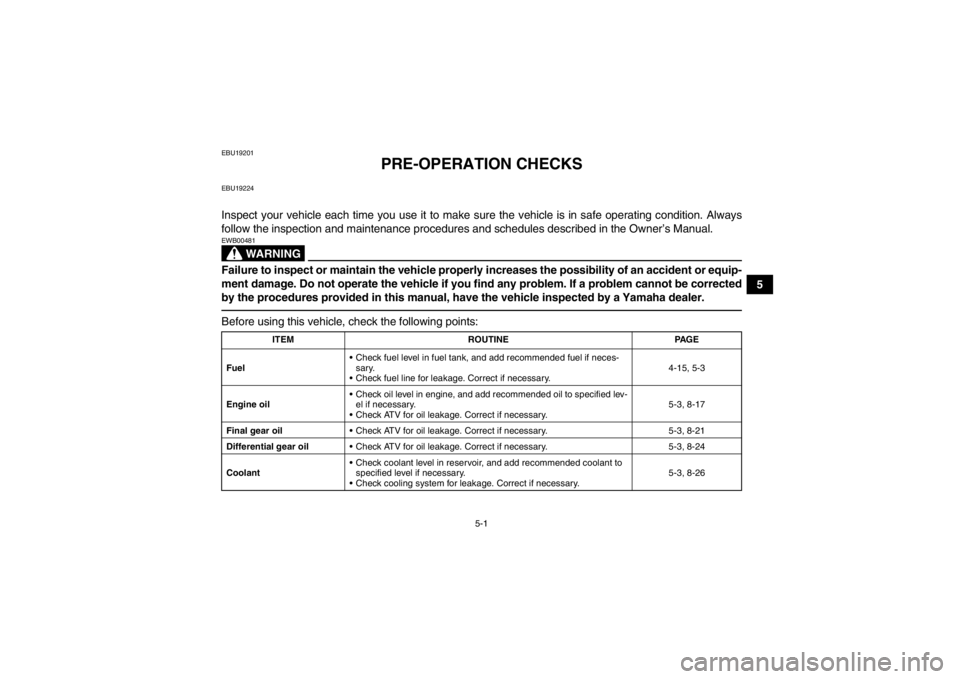
5-1
5
EBU19201
PRE-OPERATION CHECKS
EBU19224Inspect your vehicle each time you use it to make sure the vehicle is in safe operating condition. Always
follow the inspection and maintenance procedures and schedules described in the Owner’s Manual.
WARNING
EWB00481Failure to inspect or maintain the vehicle properly increases the possibility of an accident or equip-
ment damage. Do not operate the vehicle if you find any problem. If a problem cannot be corrected
by the procedures provided in this manual, have the vehicle inspected by a Yamaha dealer.Before using this vehicle, check the following points:
ITEMROUTINE PAGE
Fuel Check fuel level in fuel tank, and add recommended fuel if neces-
sary.
Check fuel line for leakage. Correct if necessary. 4-15, 5-3
Engine oil Check oil level in engine, and add recommended oil to specified lev-
el if necessary.
Check ATV for oil leakage. Correct if necessary. 5-3, 8-17
Final gear oil Check ATV for oil leakage. Correct if necessary. 5-3, 8-21
Differential gear oil Check ATV for oil leakage. Correct if necessary. 5-3, 8-24
Coolant Check coolant level in reservoir, and add recommended coolant to
specified level if necessary.
Check cooling system for leakage. Correct if necessary. 5-3, 8-26
U2LC60E0.book Page 1 Friday, March 8, 2013 1:18 PM
Page 74 of 174
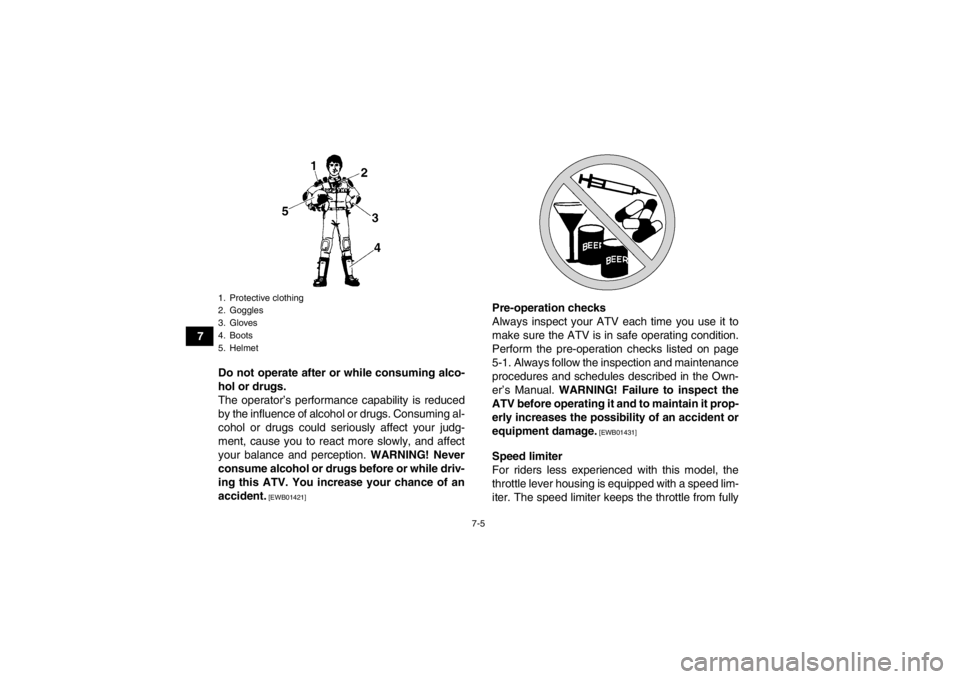
7-5
7Do not operate after or while consuming alco-
hol or drugs.
The operator’s performance capability is reduced
by the influence of alcohol or drugs. Consuming al-
cohol or drugs could seriously affect your judg-
ment, cause you to react more slowly, and affect
your balance and perception. WARNING! Never
consume alcohol or drugs before or while driv-
ing this ATV. You increase your chance of an
accident.
[EWB01421]
Pre-operation checks
Always inspect your ATV each time you use it to
make sure the ATV is in safe operating condition.
Perform the pre-operation checks listed on page
5-1. Always follow the inspection and maintenance
procedures and schedules described in the Own-
er’s Manual. WARNING! Failure to inspect the
ATV before operating it and to maintain it prop-
erly increases the possibility of an accident or
equipment damage.
[EWB01431]
Speed limiter
For riders less experienced with this model, the
throttle lever housing is equipped with a speed lim-
iter. The speed limiter keeps the throttle from fully
1. Protective clothing
2. Goggles
3. Gloves
4. Boots
5. HelmetU2LC60E0.book Page 5 Friday, March 8, 2013 1:18 PM
Page 93 of 174
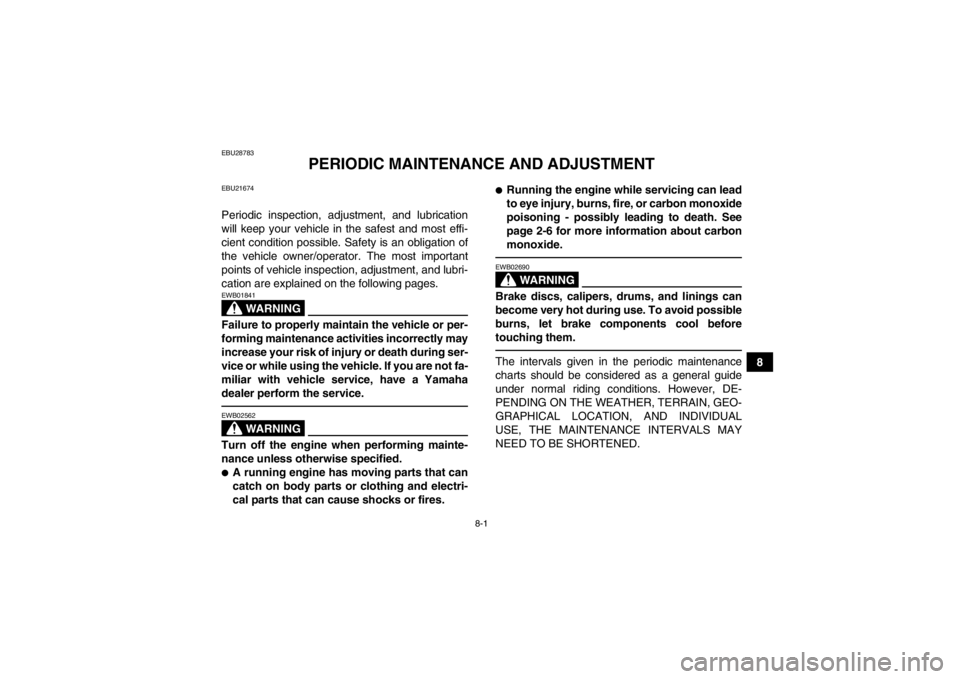
8-1
8
EBU28783
PERIODIC MAINTENANCE AND ADJUSTMENT
EBU21674Periodic inspection, adjustment, and lubrication
will keep your vehicle in the safest and most effi-
cient condition possible. Safety is an obligation of
the vehicle owner/operator. The most important
points of vehicle inspection, adjustment, and lubri-
cation are explained on the following pages.
WARNING
EWB01841Failure to properly maintain the vehicle or per-
forming maintenance activities incorrectly may
increase your risk of injury or death during ser-
vice or while using the vehicle. If you are not fa-
miliar with vehicle service, have a Yamaha
dealer perform the service.
WARNING
EWB02562Turn off the engine when performing mainte-
nance unless otherwise specified.●A running engine has moving parts that can
catch on body parts or clothing and electri-
cal parts that can cause shocks or fires.
●Running the engine while servicing can lead
to eye injury, burns, fire, or carbon monoxide
poisoning - possibly leading to death. See
page 2-6 for more information about carbon
monoxide.
WARNING
EWB02690Brake discs, calipers, drums, and linings can
become very hot during use. To avoid possible
burns, let brake components cool before
touching them.The intervals given in the periodic maintenance
charts should be considered as a general guide
under normal riding conditions. However, DE-
PENDING ON THE WEATHER, TERRAIN, GEO-
GRAPHICAL LOCATION, AND INDIVIDUAL
USE, THE MAINTENANCE INTERVALS MAY
NEED TO BE SHORTENED.
U2LC60E0.book Page 1 Friday, March 8, 2013 1:18 PM
Page 94 of 174
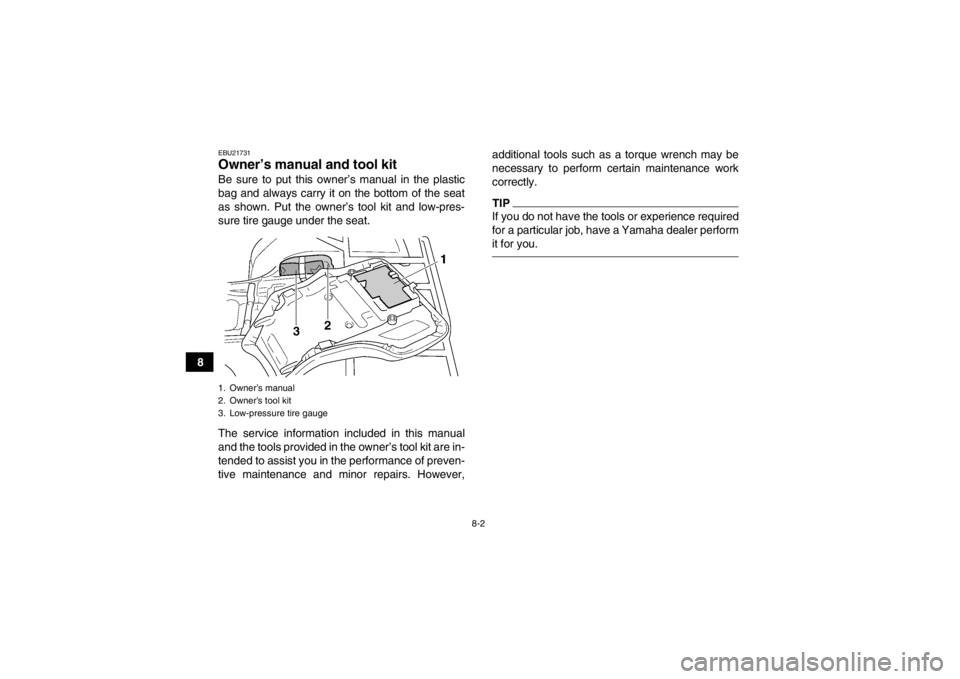
8-2
8
EBU21731Owner’s manual and tool kit Be sure to put this owner’s manual in the plastic
bag and always carry it on the bottom of the seat
as shown. Put the owner’s tool kit and low-pres-
sure tire gauge under the seat.
The service information included in this manual
and the tools provided in the owner’s tool kit are in-
tended to assist you in the performance of preven-
tive maintenance and minor repairs. However,additional tools such as a torque wrench may be
necessary to perform certain maintenance work
correctly.
TIPIf you do not have the tools or experience required
for a particular job, have a Yamaha dealer perform
it for you.
1. Owner’s manual
2. Owner’s tool kit
3. Low-pressure tire gaugeU2LC60E0.book Page 2 Friday, March 8, 2013 1:18 PM
Page 95 of 174
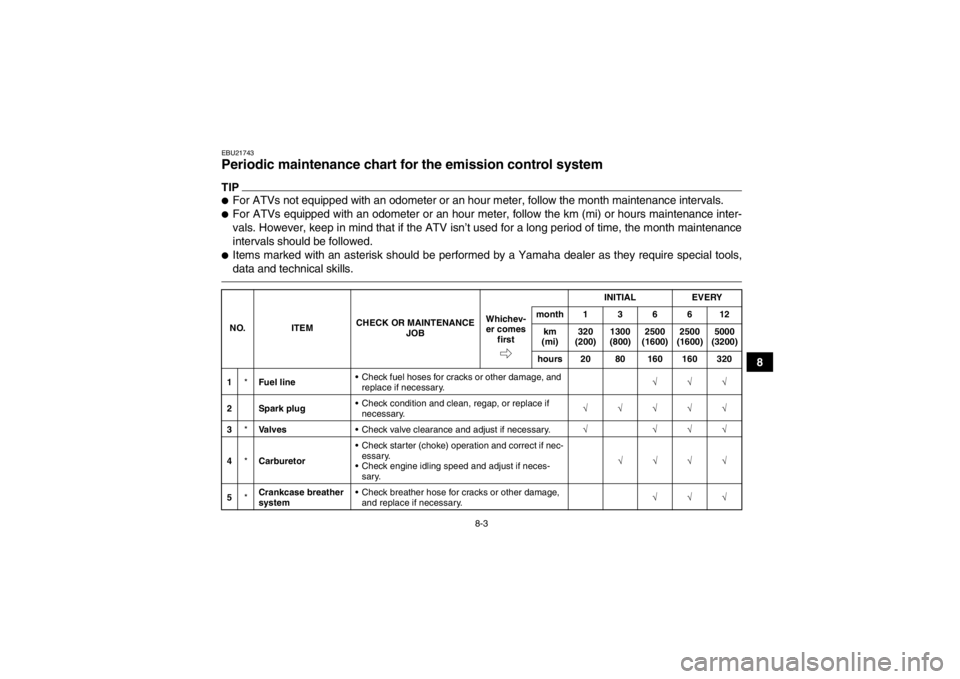
8-3
8
EBU21743Periodic maintenance chart for the emission control system TIP●For ATVs not equipped with an odometer or an hour meter, follow the month maintenance intervals.●For ATVs equipped with an odometer or an hour meter, follow the km (mi) or hours maintenance inter-
vals. However, keep in mind that if the ATV isn’t used for a long period of time, the month maintenance
intervals should be followed.●Items marked with an asterisk should be performed by a Yamaha dealer as they require special tools,
data and technical skills.NO.ITEM CHECK OR MAINTENANCE
JOB INITIAL
EVERY
Whichev- er comes first month136612
km
(mi) 320
(200) 1300
(800) 2500
(1600) 2500
(1600) 5000
(3200)
hours 20 80 160 160 320
1 *Fuel line Check fuel hoses for cracks or other damage, and
replace if necessary. √√√
2 Spark plug Check condition and clean, regap, or replace if
necessary. √√√√√
3 *Valves Check valve clearance and adjust if necessary. √ √√√
4 *Carburetor Check starter (choke) operation and correct if nec-
essary.
Check engine idling speed and adjust if neces- sary. √√√√
5 *Crankcase breather
system Check breather hose for cracks or other damage,
and replace if necessary. √√√
U2LC60E0.book Page 3 Friday, March 8, 2013 1:18 PM